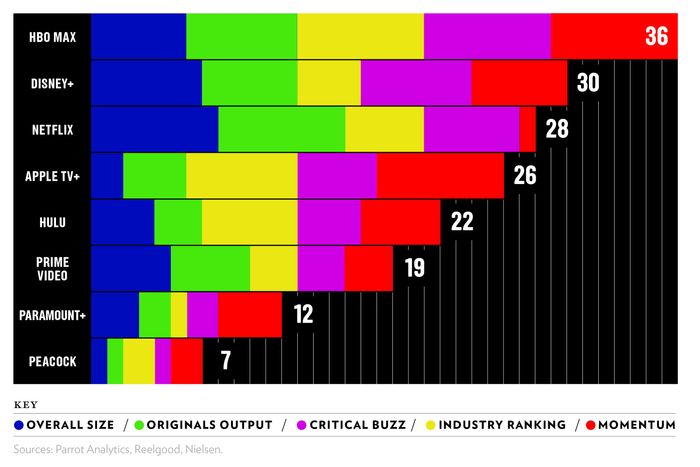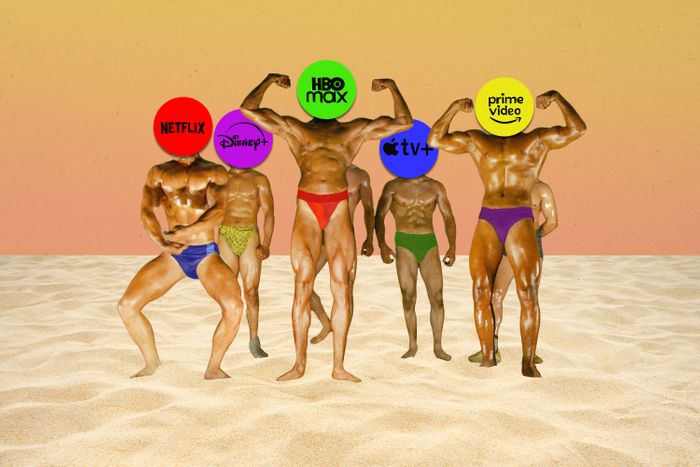
A year ago, I was asked to come up with a semi-scientific way of ranking where all the major streaming platforms stood in the multibillion-dollar effort to dominate the new TV battleground. Unsurprisingly, Netflix emerged on top — but it was a lot closer than I had expected. One Hollywood agent even told me he thought it was quite possible that Netflix’s tenure at the top would be short-lived: “One year from now, this list may feel very different,” he said. That turned out to be an understatement.
As our main story about this year’s streaming hot list details, there have indeed been many changes to our rankings. HBO Max, after barely two years in operation, has now emerged as TV’s hottest streamer — and it wasn’t even close. Disney+, riding a wave of Marvel and Star Wars hits, shot up to No. 2, while Apple TV+ exhibited some major momentum. And Netflix, the streaming colossus that upended both the TV and movie business within less than a decade? Well, it’s been a rough year. Here, my look at all the changes in this year’s streaming power rankings and how HBO Max stole away Netflix’s crown.
Netflix Nosedives
The long-reigning champ falls from first to third on the 2022 edition of our rankings, behind new leader HBO Max and runner-up Disney+. While the streaming giant still makes more original content and has more subscribers than any other platform, it lost ground in every other metric we used to evaluate streamers:
➽ Critical buzz: We’ll see what happens when the Emmy nominations are announced next week, but Netflix now seems more interested in becoming a digital version of broadcast TV than trying to match HBO in the quality department. That’s not to say it has gone full network-TV mode, as some pundits suggest: Series such as Maid, Squid Game, I Think You Should Leave, and The Chair are among the many awards contenders on the platform. Plus, Netflix is still investing heavily in making Important Movies With Prestige Directors. Problem is, as on the TV side, there is a ton more competition than ever, and many projects simply aren’t producing the critical attention they might have gotten just a few years ago. Case in point: Despite spending nearly five years and hundreds of millions to become the first streamer to win a Best Picture Oscar, in the end Apple TV+ got there first with CODA.
➽ Industry respect: Like last year, we surveyed a dozen-plus Hollywood insiders and asked how they would rank the streamers, and, again, what a difference a year made. In 2021, more than half of our respondents listed Netflix as the hottest streamer in town; this year, just four out of 14 did so. Most ranked it third or lower, allowing HBO Max and Disney+ to finish No. 1 and No. 2 in this category. “You can’t count Netflix out: Their scale and ubiquitous subscriber base is still significant,” one studio exec who took our survey said. “But they need a strategy that can help them compete with all new entrants.”
➽ Momentum: Netflix finished dead last here, and if you’re even paying a little bit of attention to the news, you know why. Its subscriber growth stalled during the first quarter of the year, and the company has now forecast it will lose upwards of 2 million members when second-quarter results get reported later this month. And as a result of that negative growth, Wall Street has punished Netflix by destroying two-thirds of its valuation as a company. Instead of innovating, the streamer is now scrambling, playing catch-up by rolling out an ad-supported plan and cutting costs through hundreds of layoffs. Everything and everywhere, the news has been bad for Netflix — and seemingly all at once.
As I noted at the top, our survey is semi-scientific. Metrics such as critical buzz and momentum are highly subjective, and even measurements that used to be fairly cut-and-dried — like how many people are actually watching various shows and movies — are now layered in mystery given the utter lack of transparency by the major platforms as well as the fact that “ratings” don’t even mean what they used to. (More on that later.) Netflix also still has a big lead in the areas where it counts, like overall subscribers and how much revenue it generates from each account. Its stock is still trading at nearly twice the price of closest rivals Amazon and Disney, at least for now. So while Netflix clearly has fallen, it has far from sunk.
HBO Max Takes Over
When HBO Max launched in May 2020, most of the conversation about the new streamer focused less on the platform or its programming and more on audiences being confused about the difference between it and classic HBO. It was a decidedly bumpy few months, which led to way too much doomsaying in some quarters of the media and on Wall Street. But that’s all history now: Two years later, HBO Max is playing the hottest hand in streaming, and it had no trouble pushing Netflix out of the top spot.
What pushed Max to the top is pretty simple: stellar content. Early on, pandemic delays gummed up the most important part of the Max programming pipeline, namely HBO original series. But the floodgates opened up last fall with the return of tentpoles Succession, Curb Your Enthusiasm, and Insecure. They were followed over the next few months by long-awaited new seasons of Euphoria, The Righteous Gemstones, Barry, and, most recently, Westworld. These familiar faves were supplemented by a steady drumbeat of strong newcomers that bore either the HBO or HBO Max brand: The White Lotus, Station Eleven, Julia, Winning Time, The Gilded Age, Somebody Somewhere, Peacemaker, Our Flag Means Death, Minx, And Just Like That …, The Sex Lives of College Girls, Tokyo Vice.
To borrow from an old radio-business slogan, the offering has been all killer and (very little) filler. Yes, HBO Max has its share of shows that come and go without notice (particularly on the unscripted side), and critics have not been kind to every title. But there is not the same bloat that plagues Netflix or even Prime Video. The result has been a nearly flawless evolution of HBO into HBO Max.
Other factors contributed to Max winning the streaming throne. For one, HBO’s historic strength at scheduling, promoting, and marketing its shows has continued in the streaming era. The biggest shows (the ones from HBO) still premiere on Sunday or Monday nights at 9 or 10 p.m. ET, with episodes rolling out weekly. It maintains a sense of community around them and makes them an event every week for two months. Plus, there’s a logic to when shows roll out: As soon as one cozy period drama such as The Gilded Age wraps, for example, another like Julia is there to try to capture a similar audience. And HBO gives its biggest shows, be they “HBO” or “HBO Max” originals, proper marketing campaigns rather than just relying on an algorithm to get fans to notice.
I also think some of the credit for why Max is doing so well right now belongs to its product team. The first year of the service was plagued by technical trouble as engineers struggled to renovate the guts of the old HBO Go service. The app itself was often buggy and prone to crashes, and the user interface — while always solid — wasn’t quite there. While I’m sure some folks are still experiencing problems (pro tip: It may be your crappy streaming device!), HBO Max is now a delight to use.
I remain a Netflix partisan when it comes to user interface, but like so many others, I find that what was once intriguing about its endless rows of content now feels like a chore. HBO Max simply feels better curated, making it easy to find a good classic movie to watch or some classic TV show to binge. There’s an actual personality to the descriptions of content rather than random words strung together by a computer. Like using an Apple product, browsing HBO Max feels like getting bumped up to business class or window-shopping in a trendier part of town. In an age of Too Much TV, the app that can make users feel as if they’re getting their money’s worth has a big advantage.
How the Other Six Streamers Fared
As for the remaining services in our survey:
➽ Disney+ (No. 2) moved up a spot mostly because Netflix fell so far versus last year. Still, the Mouse House platform’s IP machine continues to build up steam, cranking out a new Marvel or Star Wars title almost monthly. That’s a lot better than its first — or even second — year, when there were long stretches between interesting titles.
➽ As someone who has been an Apple TV+ (No. 4) bull since day one, its progress does not surprise me. Its leadership wisely realized that with the big conglomerates preparing to claw back their best content for their own platforms, it didn’t make sense to spend billions to build a library of good-not-great content based on whatever was available (like, say, MGM’s post-’80s movies before the company sold to Amazon). Instead of burning cash on hand-me-downs, Apple has been paying (some would say overpaying) to woo the biggest stars and creators. It’s a page right out of the HBO playbook, and it’s working.
➽ Hulu’s year was a lot better than its respectable middle-of-the-pack (No. 5) ranking would suggest, though it did move up a spot in the overall standings. Between Hulu-branded series, the FX pipeline, and adult-skewing movies from the Disney studios, the streaming veteran has arguably never been stronger in terms of its originals offering. Even sibling ABC stepped up its game, with Abbott Elementary and The Wonder Years finding big audiences on Hulu. The only thing holding Hulu back is its overall size: It doesn’t have the budget or marketing resources of younger sibling Disney+, and that means it often gets a bit lost in the cultural conversation. Joining a supersized Disney+ under a single app just feels inevitable.
➽ Amazon Prime Video (No. 6) fell two spots this year, and it’s mostly because of stalled momentum. Yes, The Boys is a breakout hit, and the Amazon streamer continues to offer a nice mix of originals that appeal to a broad range of demographic groups — everything from Amy Poehler’s stunningly good Lucille Ball documentary and the empowering vibe of Lizzo’s Watch Out for the Big Grrrls reality show to summer sleeper hit The Summer I Turned Pretty. The platform makes good stuff. But perhaps because it’s spending so much on big draws such as Thursday Night Football and the new Lord of the Rings series (and blockbusters such as The Terminal List), Prime just doesn’t have as steady a cadence of gotta-watch content as even Apple or Hulu. Also, it continues to be burdened with what is easily the world’s worst user interface, with the possible exception of …
➽ Paramount+ (No. 7), like Hulu, had a much better 12 months than its near-the-bottom standing indicates. It’s down so low because it’s still new (not even 18 months old), it doesn’t have the resources of the bigger guys, and, yes, the user experience — while slightly improving — seems designed to make it impossible to find something to watch from its actually big library. But its originals slate is starting to reach critical mass: Multiple spinoffs from the Taylor Sheridan Yellowstone universe, all the Star Treks (including the current, critically acclaimed Star Trek: Strange New Worlds), two shows from the Kings (Evil, The Good Fight), the Real World Homecoming franchise, and one of the best new network comedies in years (CBS’s Ghosts). Paramount Pictures’ feature films are also heading to the app within two months of bowing in theaters (though not Top Gun: Maverick, I’m guessing), and the live TV option for CBS fare is attractive to many cord-cutters who dig “America’s No. 1 Network.” No, it doesn’t feel essential yet, but you can see a path forward.
➽ Peacock (No. 8) once again finishes at the bottom of our survey, though because Paramount+ is new this year, the Comcast streamer actually fell a spot. There is no denying Peacock had its strongest stretch yet during the first quarter of 2022: The Winter Olympics experience was vastly improved from 2021’s Summer Games, Marry Me was a delightful hit, and while critics were mixed, Bel-Air made a ton of noise. Its original comedies (Girls5eva, Rutherford Falls, Killing It) feel like the streaming evolution of NBC’s old Thursday-night Must-See TV comedy lineup. But the platform still seems all over the map when it comes to dramas and reality shows, and so many of its series come and go without anyone seeming to notice. NBC’s prime-time lineup will begin streaming exclusively on Peacock this fall (ditching Hulu), giving the service yet another chance to reboot as it looks for a winning strategy.



